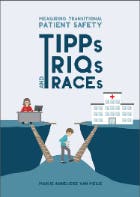Marije van Melle
‘Measuring transitional patient safety; TIPPs, TRIQs and TRACEs’

- Datum
- (Co) promotoren
- 17-04-2018
- prof.dr. N.J. de Wit, dr. D.L.M. Zwart, dr. H.F. van Stel
Samenvatting
Often several healthcare professionals are involved in treatment of one patient. During transitions between settings (e.g. general practice and hospital), such as referral, discharge, and visits to the outpatient specialty care, adequate exchange of information is vital. This thesis was part of the Transitional Incident Prevention Programme (TIPP) aiming to develop an improvement strategy and measurement tools for improving transitional safety between hospitals and their regional partnering general practices. First, we provided an overview of the nature of 548 transitional safety incidents (TSIs) reported by both healthcare professionals and patients, using an array of different data collection methods. Most TSIs concerned handover correspondence from hospital to general practitioner, and referral. Second, we reviewed literature to identify all measurement tools and explored outcomes used to measure transitional patient safety as valid measurement tools are needed to create a sense of urgency and monitor improvement. The overall quality of the 17 validated measurement tools identified was acceptable; however, validation was mostly incomplete, and the validated tools were hardly used. Measurement tools for transitional patient safety culture and for patient experienced transitional patient safety were lacking. To fill these gaps, we developed and validated two questionnaires: one measuring transitional patient safety culture in healthcare professionals (the TRACE questionnaire) and another measuring patient experienced transitional patient safety (the TRIQ questionnaire). Additionally, we developed a medical record review study identifying TSIs in a transitional medical record linking general practitioners’ and hospitals’ patient records. We found that one of three in-hospital medication prescription changes could not be found in the general practitioner’s medical record within three months. Lastly, to improve transitional patient safety in our participating three hospitals and 62 general practices, we implemented a multifaceted complex intervention aimed at three major aspects of transitional patient safety: 1) optimising the process of care transitions, 2) improving the transitional patient safety culture, and 3) stimulating patient participation. After the intervention, we found no improvement on the primary outcome of major harm (death or readmissions) nor on healthcare use. Neither the number of TSIs as measured in medical records and by reporting changed. Yet, we did find a positive effect of TIPP on patient-experienced TSIs (decreasing from 38% to 31%) and a negative effect on the transitional patient safety culture, probably indicating a response shift induced by raised awareness. As awareness is the first step in behaviour change and subsequently improvement of transitional patient safety, we believe TIPP has the potential to spur improvement in transitional patient safety overtime. For this, the gap between settings needs to be bridged. We need to create awareness, bring stakeholders together for regular learning about each other’s thinking and working processes, and connect IT systems. Improving and ensuring transitional patient safety is a shared responsibility of both healthcare providers and leading bodies, such as government and healthcare insurers. Also, patients can contribute to their own transitional patient safety. For this, healthcare professionals should identify patients who are willing and capable, and inform and support them for engaging in transitional safety.
